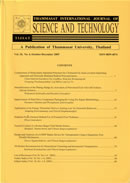ThaiScience
ThaiScience
THAMMASAT INTERNATIONAL JOURNAL OF SCIENCE & TECHNOLOGY
Volume 26, No. 02, Month APRIL, Year 2021, Pages 210 - 219
Expression of helicobacter pylori virulence genes under atmospheric condition
Nantapong Ritdet, Panadda Rojpibulstit, Sasichai Kangsadalampai
Abstract Download PDF
Helicobacter pylori, a dimorphic gram-negative microaerophilic bacterium, is a major causative factor for many gastrointestinal diseases and is also a carcinogenic agent of gastric cancer. H. pylori is capable of surviving in adverse environments by transforming its shape from spiral to coccoid. It was previously reported that the atmospheric oxygen-induced coccoid H.pylori retained its ability to produce virulence factors. In this study, the coccoid mRNA levelsof the major virulence genes were analyzed by quantitative RT-PCR using the SYBR greenfluorescein method. H. pylori was converted into its coccoid form by incubating it in anatmospheric oxygen environment; the expression of virulence genes while in the coccoid formwere compared with that of the bacteria in spiral form. After 24 hours of oxygen exposure,approximately 85.52% of the bacteria were coccoid-shaped. Interestingly, mRNA for all 10virulence factors studied herein were continuously produced, with the highest up-regulationoccurring for the cagA gene, increasing by over 2.5-fold (P < 0.01). The information in thisstudy provides insight into the functions of coccoid H. pylori and how it may still remaininfectious in adverse environments.
Keywords
Helicobacter pylori, Virulence gene, Atmospheric oxygenTHAMMASAT INTERNATIONAL JOURNAL OF SCIENCE & TECHNOLOGY
Published by : Thammasat University
Contributions welcome at : http://www.tijsat.tu.ac.th
